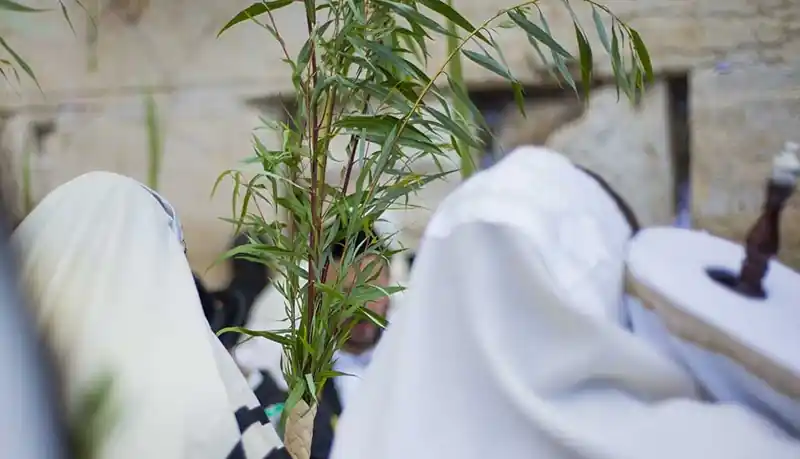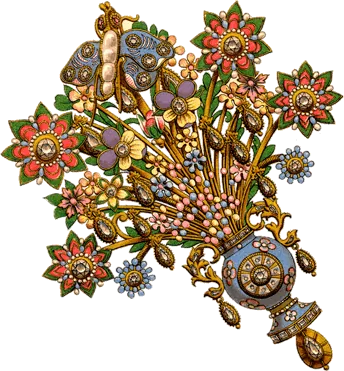The seventh day of Sukkot is called Hoshana Rabbah. The Book of John records that it was on the last day of Sukkot that Yeshua stood and cried out.
The seventh day of Sukkot is called Hoshana Rabbah – it is a semi-holiday in its own right; and is still counted among the intermediate days of Sukkot i.e. Chol HaMoed. The name “Hoshana Rabbah” means “the great hoshanah.”
A “hoshana” is a series of seven liturgical poems calling upon God to rescue and redeem the Jewish people, primarily by sending rain.
Today, during the course of the Hoshana Rabbah morning services, all the Torah scrolls are taken out of the Ark and are held by people standing around the synagogue’s bimah. The congregation then makes seven circuits around the bimah while reciting the Hoshanot prayers, with the Four Kinds in hand.
The climax of the hoshanot prayers express the hope for a speedy coming of the Messiah: “Kol mevasser, mevasser v’omer” the congregation proclaims! Which translates to, “The voice of the Herald heralds and says...”
The "Voice of the Herald" is a reference to the Prophet Elijah.
At the conclusion of the Hoshanot, a bundle of five willows are taken, and with it, it is customary for all—men, women, and even small children— to strike the ground five times, symbolizing the elimination of sin. Finally, after the bundle is used, many have the custom of throwing the willows onto the top of the Ark.
In Temple Times
In the days of the Temple, Hoshanah Rabbah was considered a “mini Yom Kippur”. According to the rabbis of the Talmud, this was a day on which the entire Jewish community was judged by God to be worthy of the seasonal rains.
As we are well aware, rain is essential to life: Without water, it would be impossible to quench our thirst. Without rain, it would be impossible to irrigate our crops. If there were ever a more telling depiction of the necessity of rain, just look at Google Maps and consider how rivers [even in the most arid places] are surrounded by green vegetation on both banks! Clearly, without rain, the earth could not endure:
Beresheet Rabbah 13:3,
. . . . Rabbi Shimon Bar Yochai said: Three things are equal in importance--land, humanity, and rain. Rabbi Levi bar Hiyya said: and the three of them each have three letters, to teach you that if there is no land, then there is no rain, and if there is no rain there is no land, and without either of them there is no humanity.
When considering how much our wellbeing and economy depends on bountiful rainfall, it is easy to see how important this day really was. The need for rain over the winter months in Israel was and is an ongoing need for the welfare of the people.
The Day of the Willow
In the days of the Temple, the primary observance of Hoshana Rabbah was “the taking of the willow.”
In addition to the ‘Four Kinds – Arba Minim’ taken every day of Sukkot, it was the custom to take an additional willow on the seventh day of Sukkot.
According to the Mishnah (Sukkah 4:5), large eighteen-foot willow branches were placed around the altar every day of the festival; and the people would encircle the altar and recite, “Hoshiah na! Save us, please!”
Sukkah 4:5,
There was a place at the foot of Jerusalem called Motza. Each day of Sukkot, the people would descend there and cut down huge willow leaves. These branches were exceptionally long-their height reached 11 amot. The worshippers would place these branches all along the foundation of the altar, with their heads bent over the top [of the altar]"
This ancient custom actually dates back to the days of the Prophets: Every day of Sukkot the altar was circled once, to the sounds of supplications for divine assistance; and on Hoshana Rabbah, the altar was circled seven times.
As mentioned at the beginning of the article, the memory of this special mitzvah, which is not biblical in origin, continues to live on in modern observance even in the absence of the Holy Temple.
Water Libation
Another mitzvah that was observed in the Temple during Sukkot was the water libation. Like the special mitzvah of willows, the water libation was handed down orally as halacha l’moshe mi’sinai – details of religious observance that God taught to Moses at Sinai.
The historian Josephus calls the ceremonial drawing of water from the Pool of Siloam “the very sacred close of the year,” since the amount of rainfall over the next few months would directly impact the harvest in the spring.
Like the observance of the willow, the water libation also took place at the altar.
Waters of Shiloh
Every day of the festival, the priests descended down below the foothills of Mount Moriah, down below the City of David, to a natural spring called Shiloach.
This ancient spring, which literally dwelled in the shadow of the Holy Temple, was actually the original source of Jerusalem’s water.
It was at the waters of Shiloh that the priests would fill a golden flask with about ½ liter of pure water, and ascend back up to the Temple Mount, carrying the flask with song and elating praises to God.
As they entered the Temple courts from the south through “the Water Gate” (it received its name on account of this event) their steps were greeted by the sound of trumpets and shofar blasts, in fulfillment of the words of the Prophet Isaiah (12:3) which says,
"With joy you shall draw water out of the wells of salvation.”
The joy of this procession was so immense, and the celebrations so uplifting, that the sages of Israel emphatically stated: "Whoever has never seen the celebrations of the Festival of the Water Libation-has never experienced true joy in his life."
Once in the Temple, the priest who had the honor of performing this service carried the golden flask up the ramp of the Altar, and poured libations at the southwest corner.
Yeshua on Hoshana Rabbah
As mentioned earlier, the Hoshanot are climaxed by a series of liturgical verses expressing hope for the speedy coming of the Messiah.
The New Testament records that it was on the last day of Sukkot (i.e., “the great day”) – and most likely after the water libation - that Yeshua stood up and cried out, “If anyone thirsts, let him come to me and drink!”
John 7:37, 40-42:
On the last and greatest day of the festival, Jesus stood and said in a loud voice, “Let anyone who is thirsty come to me and drink. Whoever believes in me, as Scripture has said, rivers of living water will flow from within them.”
On hearing his words, some of the people said, “Surely this man is the Prophet.” Others said, “He is the Messiah.” Still others asked, “How can the Messiah come from Galilee? Does not Scripture say that the Messiah will come from David’s descendants and from Bethlehem, the town where David lived?”
The observance of Hoshanah Rabbah clearly expresses the understanding that physical rain is essential to sustaining life. So it was that Yeshua pointed to himself as the source of “spiritual rain,” or “living water” that would sustain their spiritual lives. The “rain of blessing,” then, referred to the refreshing power of the Holy Spirit that would become an inner source of life for those who believe…
By this he meant the Spirit, whom those who believed in him were later to receive. (John 7:39)
Elsewhere in the Gospel writings, we see of Yeshua drawing on this theme of water:
“Blessed are those who hunger and thirst for righteousness, for they shall be satisfied. “(Matthew 5:6)
“Everyone who drinks of this water will be thirsty again, but whoever drinks of the water that I will give him will never be thirsty again. The water that I will give him will become in him a spring of water welling up to eternal life.” (John 4:13-14)
Final Judgment
As we have briefly established, the seventh day of Sukkot is considered the final day of the divine “judgment” in the holiday season. On this day, the fate of the new year is determined. It is the day when the verdict that was issued on Rosh Hashanah and Yom Kippur is finalized.
The Midrash tells us that God told Abraham: “If atonement is not granted to your children on Rosh Hashanah, I will grant it on Yom Kippur; if they do not attain atonement on Yom Kippur, it will be given on Hoshana Rabbah.”
If Hoshana Rabbah represents “judgement delivered,” then Yeshua was teaching that the Spirit of God would deliver the good verdict – and the true freedom – that Messiah secured for us through his sacrificial death as our atonement before God.


